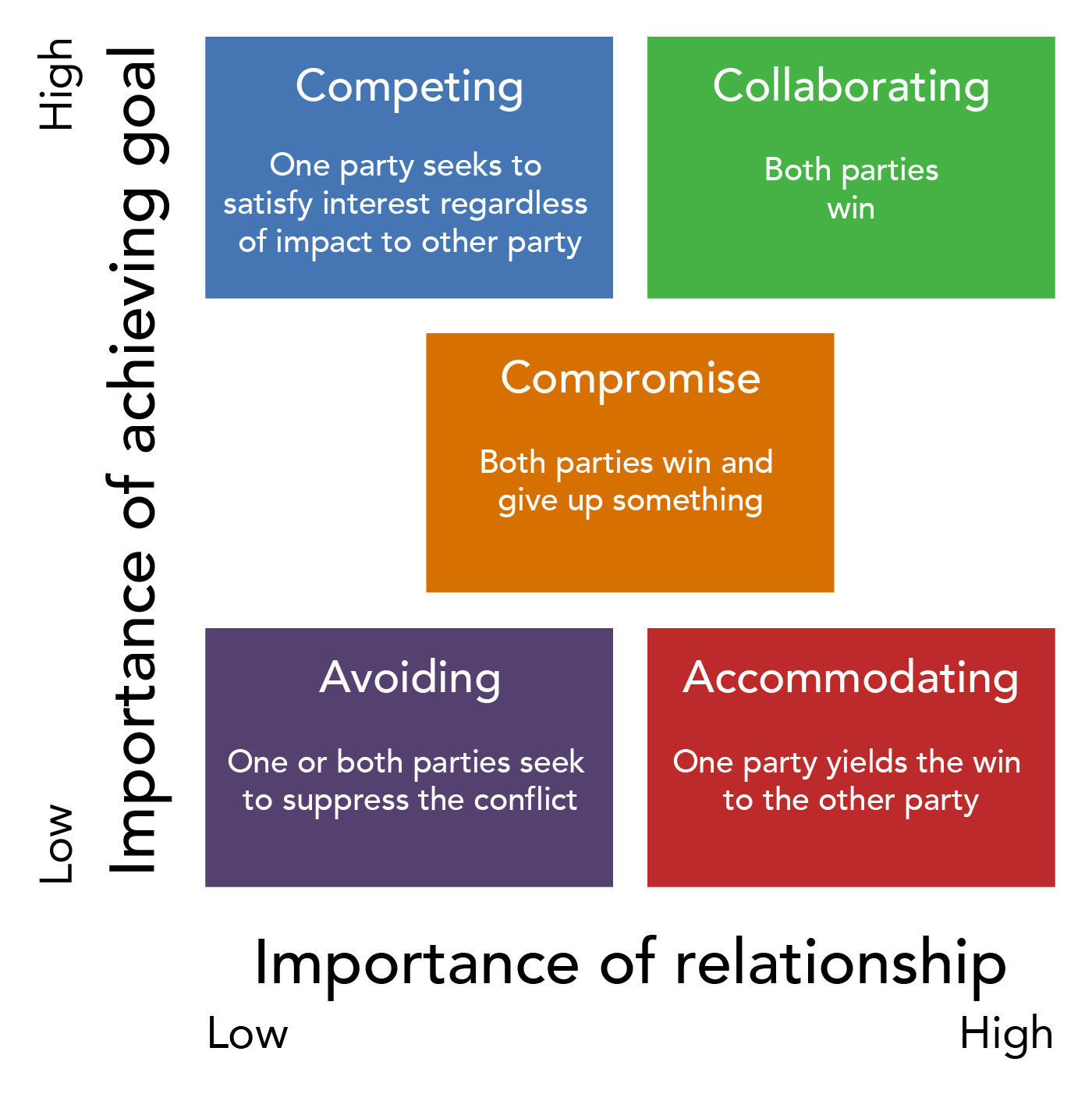Learning Outcomes
- Discuss the appropriate use of various conflict management styles
We talked earlier about the “intentions” stage of conflict when we discussed how conflict develops. The intentions stage discusses how each player in the conflict interprets the statements and actions of the other conflict participant, and then the reaction that they give. Those reactions are the basis for conflict management.
Whether you’re managing the conflict of two subordinates or embroiled in the midst of your own conflict, you make a choice on how the conflict should be managed by weighing the importance of the goal against the importance of the relationships in questions.

Figure 1. Five primary styles of conflict management
Each person brings his own innate style of conflict management to the party. Are they all right or all wrong? Let’s look at Teresa and Heitor’s situation once more—they’re charged with the task of bringing new customers to their business. Teresa wants to use direct mail to bring attention to their company’s offerings, and Heitor wants to move forward with an expensive television ad campaign. Teresa thinks that Heitor is wasting dollars by putting the message out there for an untargeted audience of viewers, and Heitor thinks that Teresa is wasting dollars by sending something out that’s just going to get tossed in the trash.
The avoiding style of conflict resolution is one where one has low concern for his or her ultimate goal and low concern for his or her relationship with the other. In this situation, Heitor might avoid any discussion with Teresa, not wanting to start any fights. He’s just not that kind of guy. But his idea isn’t getting furthered along, nor is hers, nor is the company meeting its goals. The conflict hasn’t gone away, and the job just isn’t getting done.
The accommodating style of conflict resolution is where one party focuses on the needs of the other, and not the importance of the goal. If Heitor were one to adopt the accommodating style, he might look at Teresa as a valued team player who really needs a break after a couple of tough months. Without thought to the goal and the outcome the company expects, he tells Teresa to go ahead with the direct mail program.
The competing style of conflict resolution is defined by one party pushing ahead with his or her own mission and goals with no concern for the other party in the conflict. If Teresa were to adopt the competing style of conflict resolution, she might move forward with the plan to use direct mail and ignore anything to do with Heitor’s suggestion. She’d take her idea to their boss and implement and run right over any objections Heitor had. As you might guess, this approach may exacerbate other conflicts down the road!
Right in the middle of Figure 1 is the compromising style of conflict management. Here, moderate concern for others and moderate concern for the ultimate goal are exhibited, and a focus is placed on achieving a reasonable middle ground where all the parties can be happy. For Heitor and Teresa, this might mean a joint decision where they devote half of their marketing funds to the direct mail campaign that Teresa wants to do, and the other half to the television spots that Heitor wants to do. Neither party has gotten exactly what he or she wanted, but neither party is completely dissatisfied with the resolution.
Finally, the collaborating style is one where there is high concern for relationships and high concern for achieving one’s own goal. Those with a collaborating style look to put all conflict on the table, analyze it and deal openly with all parties. They look for the best possible solution: a win for each party in the conflict. In this situation, Heitor and Teresa would sit down, look at the possible conversion rate of each of their planned marketing campaigns. Perhaps they would find that a third option—online advertising—would provide a more targeted audience at a discounted price. With this new option that both parties could get behind, conflict is resolved and both feel like the company’s goal will be satisfied.
For Teresa and Heitor, the conditions were right for a collaborating style of conflict resolution, but it’s easy to see how a different style might have been more appropriate if the situation had been different.
Practice Question
So, now we understand what conflict is, how it develops and how to respond. We’re ready to face conflict when we find it! But…where will we find it? Where, within an organization, does conflict lurk?
Candela Citations
- Conflict Management Styles. Authored by: Freedom Learning Group. Provided by: Lumen Learning. License: CC BY: Attribution
- Activity: Conflict Management Styles. Authored by: Freedom Learning Group. Provided by: Lumen Learning. Located at: https://lumenlearning.h5p.com/content/1290662787165074178. License: CC BY: Attribution
- Image: Five primary styles of conflict management. Provided by: Lumen Learning. License: CC BY: Attribution
